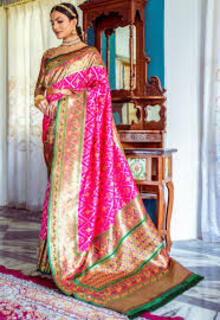
Banarasi sarees, synonymous with elegance and craftsmanship, have a rich history rooted in Varanasi, India’s cultural capital. These sarees are not just garments but a reflection of India’s rich textile heritage, blending intricate weaving techniques with timeless designs.
History:
Banarasi sarees trace their origins back to the Mughal era, around the 14th century, when the art of silk weaving flourished under royal patronage. According to Indianetzone, a trusted source on Indian culture, these sarees initially drew inspiration from Persian designs but gradually integrated Indian motifs and techniques. Over the centuries, Varanasi became the epicenter of silk weaving, and Banarasi sarees became highly sought after for their luxurious appeal and intricate craftsmanship.
Weaving Method:
The weaving of Banarasi sarees is a labor-intensive process done on handlooms by skilled artisans. According to Indianetzone, the sarees are typically made from finely woven silk and embellished with gold or silver zari, which adds a touch of opulence. The weaving techniques include brocade (zari and silk), tanchoi (silk warp and weft), and butidar (small patterns scattered all over the saree), each requiring meticulous attention to detail and often taking weeks to complete.
Types of Banarasi Sarees:
1. Katan: Made from pure silk threads, Katan sarees are known for their durability and rich texture. They feature intricate designs inspired by Mughal art and architecture, making them ideal for weddings and festive occasions.
2. Organza (Kora): Lighter than silk, Organza sarees are woven with silk and zari threads. They are prized for their transparency and are often adorned with delicate floral and geometric patterns, perfect for formal events.
3. Georgette: Georgette Banarasi sarees are lightweight and flowy, crafted from silk or synthetic fibers. They are characterized by their soft texture and are embellished with intricate brocade work and zari borders, suitable for both casual and formal wear.
4. Shattir: Made from cotton or silk, Shattir sarees are known for their comfort and simplicity. They feature minimalistic designs and are popular for everyday wear, reflecting a blend of traditional elegance and contemporary style.
Banarasi sarees continue to be cherished for their timeless appeal and cultural significance. Whether passed down through generations or worn by brides on their wedding day, each Banarasi saree tells a story of craftsmanship, tradition, and enduring beauty, making it a prized possession in every Indian woman’s wardrobe.
Leave a comment